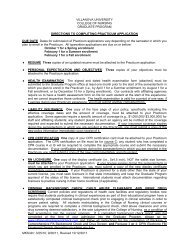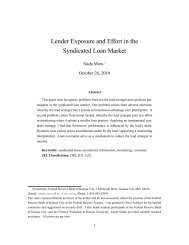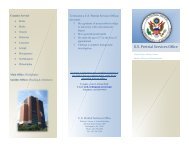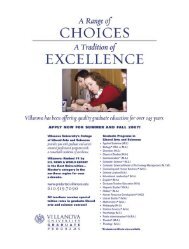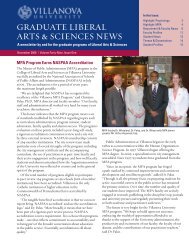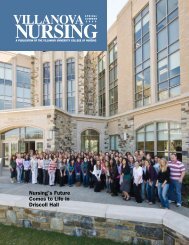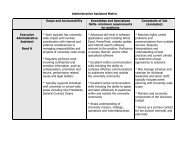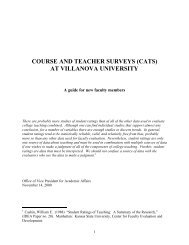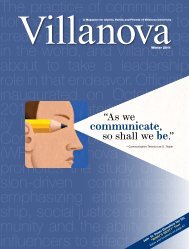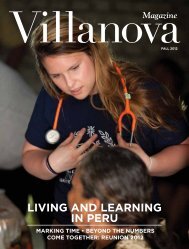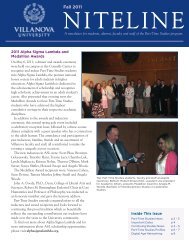A Center of Excellence: An Environment for Learning - Villanova ...
A Center of Excellence: An Environment for Learning - Villanova ...
A Center of Excellence: An Environment for Learning - Villanova ...
You also want an ePaper? Increase the reach of your titles
YUMPU automatically turns print PDFs into web optimized ePapers that Google loves.
Exercise and Disease Prevention: Toward Better Outcomes <strong>for</strong> African-American Women<br />
The rising prevalence <strong>of</strong> overweight<br />
adults in the United States, particularly<br />
African-American and lower social status<br />
Euro-American women, continues to be a<br />
focus <strong>of</strong> research in the College <strong>of</strong> Nursing.<br />
Faculty members are identifying strategies<br />
that address this health-care issue.<br />
Fewer than 30 percent <strong>of</strong> minority women<br />
in the United States per<strong>for</strong>m physical activity at<br />
a level that is sufficient to provide health benefits,<br />
according to research from the <strong>Center</strong>s <strong>for</strong><br />
Disease Control and Prevention. Reasons <strong>for</strong><br />
the increase in weight among women, particularly<br />
African-American women, have not been<br />
thoroughly investigated.<br />
In one pilot study, two Nursing faculty<br />
members examined factors that influence<br />
exercise behaviors <strong>of</strong> African-American women.<br />
Assistant Pr<strong>of</strong>essor Sara Reeder, Ph.D., R.N.<br />
and Associate Pr<strong>of</strong>essor Mary Pickett, Ph.D.,<br />
R.N. designed and conducted a cross-sectional<br />
survey <strong>of</strong> 75 African-American women recruited<br />
from church-related and social groups. The<br />
study examined variables including selected<br />
demographic in<strong>for</strong>mation, co-morbid conditions,<br />
perceived barriers to exercise, exercise<br />
self-efficacy, diet self-efficacy, depression,<br />
self-esteem, social support and quality <strong>of</strong> life.<br />
The average age <strong>of</strong> women in the sample<br />
was 47 (range 26 to 79 years) with a mean<br />
body weight <strong>of</strong> 169 lbs. Preliminary data-analysis<br />
revealed that two-thirds <strong>of</strong> the women had<br />
body mass index (BMI) values that were classified<br />
as overweight (BMI = 25 < 30) or obese<br />
(BMI = >30). Sixty per cent were married, 68<br />
percent were employed full-time, 91 percent<br />
had an associate degree or higher education<br />
and 99 percent had an annual combined income<br />
More health promotion education is needed<br />
to help African-American women find strategies<br />
to schedule time <strong>for</strong> exercise, according<br />
to preliminary research by Sara Reeder,<br />
Ph.D., R.N. (below, left) and Mary Pickett,<br />
Ph.D., R.N. (below, right).<br />
level above $20,000. Overall, the subjects<br />
reported few co-morbid conditions.<br />
The majority <strong>of</strong> these women reported<br />
“no problem” or “little problem” with finding<br />
time, facilities, family support and weather<br />
conditions related to personal exercise behaviors.<br />
In addition, the majority indicated they<br />
were knowledgeable about the importance<br />
<strong>of</strong> exercise <strong>for</strong> maintaining health. While the<br />
sample reported a low level <strong>of</strong> barriers to<br />
exercise, only 19 percent reported being<br />
“very confident” that they could fit exercise<br />
into their daily routines.<br />
Results <strong>of</strong> the diet self-efficacy analysis<br />
revealed that the sample reported moderately<br />
low to very low levels <strong>of</strong> confidence related<br />
to reaching ideal weight by eating healthy<br />
food (52 percent), staying on a healthy<br />
diet when in a rush (61 percent), cutting<br />
out unhealthy snacks (54 percent) and<br />
maintaining a healthy weight (64 percent).<br />
From their preliminary results, Reeder<br />
and Pickett find evidence <strong>of</strong> a need to provide<br />
health promotion education on strategies <strong>for</strong><br />
scheduling exercise into busy lives, as well<br />
as influencing the dietary habits <strong>of</strong> African-<br />
American women to help them maintain a<br />
healthy body weight. Now analyzing their<br />
data further, they plan to use the pilot data<br />
to support future intervention studies related<br />
to exercise and diet in African-American<br />
women who have been diagnosed with<br />
breast cancer and cardiovascular disease.<br />
Reeder will also continue with her research<br />
into other cardiovascular issues relating to<br />
myocardial infarction.<br />
Recently, Reeder received $15,000<br />
from the Christian R. and Mary F. Lindback<br />
Foundation to study physiological and<br />
psychosocial predictors <strong>of</strong> myocardial<br />
reinfarction in women. Heart disease kills<br />
approximately twice as many women each<br />
year compared to all types <strong>of</strong> cancer and is<br />
the leading cause <strong>of</strong> disability in American<br />
women over 40 years <strong>of</strong> age. Despite better<br />
post-infarction left ventricular ejection fraction<br />
and higher incidence <strong>of</strong> non-Q-wave<br />
myocardial infarction (MI), women have<br />
poorer outcomes than men. The purpose<br />
<strong>of</strong> Reeder’s study is to identify factors that<br />
may increase risk <strong>of</strong> reinfarction among<br />
women who have survived an initial MI.<br />
This longitudinal study may provide<br />
in<strong>for</strong>mation to enhance our understanding <strong>of</strong><br />
factors that contribute to poorer outcomes<br />
experienced by women who have had an MI.<br />
Data from this project will provide in<strong>for</strong>mation<br />
that can be used <strong>for</strong> secondary prevention<br />
in women who experienced an initial MI.<br />
Where Hearts and Minds Connect to Aid Philadelphia’s Poor<br />
For <strong>Villanova</strong> nurses, “service activities<br />
among students and faculty remain central<br />
to our mission,” noted Connelly Endowed<br />
Dean and Pr<strong>of</strong>essor M. Louise Fitzpatrick,<br />
Ed.D., R.N., FAAN.<br />
One <strong>of</strong> the newest service endeavors comes<br />
in conjunction with a project <strong>of</strong> the Augustinian<br />
Province, under the direction <strong>of</strong> the Very<br />
Rev. John E. Deegan, O.S.A., Prior Provincial.<br />
Called ADROP (Augustinian Defenders <strong>of</strong><br />
the Rights <strong>of</strong> the Poor), the project has<br />
among its concerns the health <strong>of</strong> immigrant<br />
groups within Philadelphia.<br />
A <strong>Villanova</strong> nurse practitioner faculty<br />
member, Karen McGinn ’73 B.S.N., M.S.N.,<br />
CRNP, practices at a free clinic on a weekly<br />
basis in addition to her teaching. “Our objective,”<br />
Fitzpatrick emphasized, “is to help<br />
develop this health service while providing<br />
care to a group that is truly needy and at<br />
the same time developing a practice site<br />
<strong>for</strong> our students.”<br />
At St. Rita’s Clinic in Philadelphia, Karen<br />
McGinn ’73 B.S.N., M.S.N., CRNP, clinical assistant<br />
pr<strong>of</strong>essor, provides guidance to Kate Garrison,<br />
a <strong>Villanova</strong> Nurse Practitioner student (right).<br />
F ALL 2004 9



